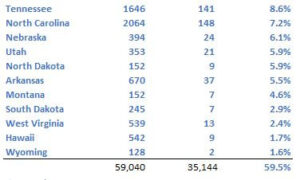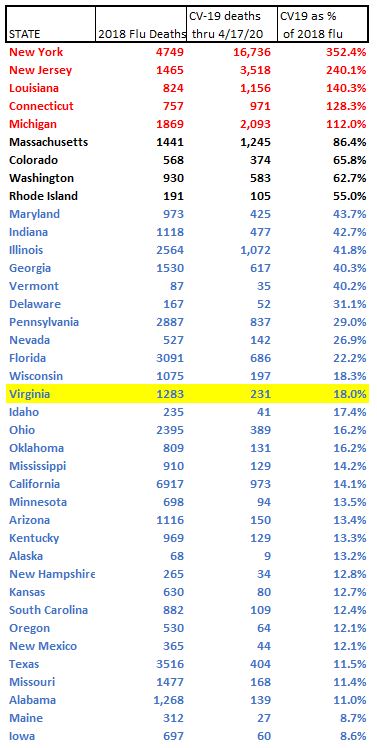As the nation starts to roll back the social distancing measures that have dampened the spread of the COVID-19 virus, it is useful to remember that the United States is a big, diverse country, and measures that make sense in one place might not be suitable for another. This table, supplied by reader James Young, drives home that simple message. Young expresses the incidence of COVID-19 deaths as a percentage of the incidence of deaths from influenza, a disease that Americans rarely freak out about. The variance is extraordinary — a three-to-one ratio in New York to less than one in fifty ratio in Wyoming.
 Virginia is caught in that middling netherworld between the two extremes — COVID-19 deaths at 18% of influenza deaths (and counting) — which makes it more difficult to decide whether to maintain the social-distancing crackdown or to start loosening up. Here is Young’s take on the data:
Virginia is caught in that middling netherworld between the two extremes — COVID-19 deaths at 18% of influenza deaths (and counting) — which makes it more difficult to decide whether to maintain the social-distancing crackdown or to start loosening up. Here is Young’s take on the data:
Five states (CT, NJ, NY, LA, MI) have more coronavirus deaths than last year’s flu deaths. Four states (MA, RI, WA, CO) have fewer deaths than last year’s flu season, but are within 50-100% of last year’s total number of deaths.
The remaining 41 states (see chart below) have fewer than 50% of last year’s flu deaths and of those, 33 have less than even 1/4 as many deaths as the last “regular” flu season. Of those, 13 states have COVID deaths at less than 10% of last year’s flu deaths. Hawaii for example, had 542 flu deaths, but only 9 COVID deaths. Who’s zooming who?
Clearly, at this time and pending further developments, COVID-19 is largely a regional (Northeast) disease with a few additional large-scale outbreaks in a couple of scattered parts of the country. Yet, all states but North Dakota are in lock downs – as though they are equally afflicted by COVID-19. They are not.
It is time to judiciously open states, like the 13 states that have fewer than 10% of last year’s seasonal flu deaths.
What about states in between, such as Virginia? It’s not black and white. The argument I have advanced, and will continue to do so, is to identify lower-risk demographics (young people), lower-risk regions (rural counties), lower-risk health conditions (no co-existing conditions or immunity conferred by recovery from the disease), and lower-risk activities (walking outdoors), for whom we would create carefully tailored exemptions from the broader restrictions. Each step of the way, we would pause and observe the effects. If they prompt a rebound, we retract. If they are minimal, we move on to the next set of steps.
The epidemic is dynamic, always changing, and our information is imperfect. So is the economy, which is gathering momentum for a meltdown of its own. We we can move seek a better equilibrium of protecting lives and restoring economic activity than the one we have now.
— JAB



